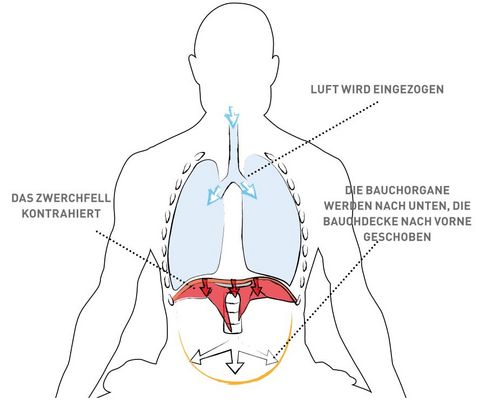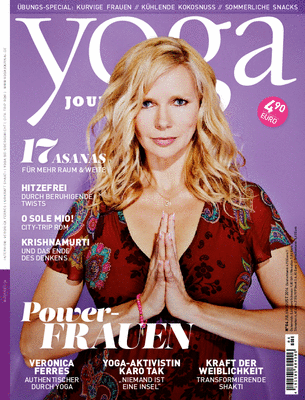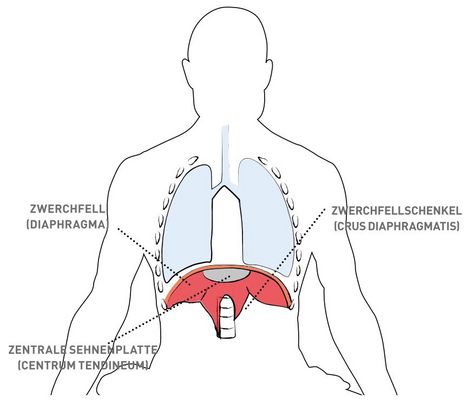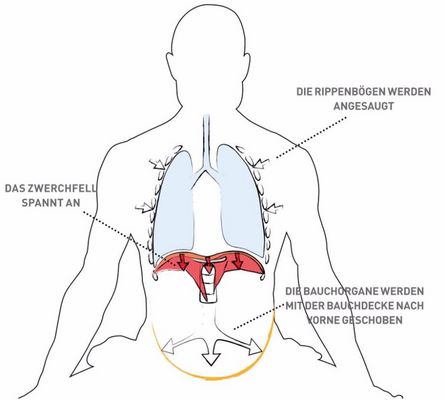
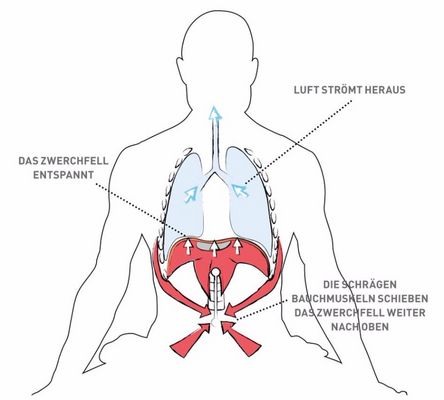
The lung is attached to the walls of the thorax via a thin layer of liquid and a vacuum, which gives it its shape. On the sides, the thorax is surrounded by the ribs and it is separated from the abdomen by the muscle plate of the diaphragm. The diaphragm, in turn, is attached to the lumbar spine by its two so-called 'legs', the crura diaphragmatis, and to the ribs surrounding it. Strong muscles stretch up from this circular basis. In the centre, they meet to form a dome-shaped plate of tendons (centrum tendineum, Image 1).
The diaphragm is our strongest respiratory muscle. For this reason, it should be the main driving force of our breathing movements in all kinds of healthy respiration, be it relaxed abdominal respiration or energising respiration with bandhas.
Deep abdominal breathing brings relaxation
When the diaphragm contracts, the sides of the dome shorten, i. e. the dome itself becomes flatter. If the costal arches, to which the basis of the diaphragm is attached, remain mostly motionless in the process, the diaphragm pulls down the central tendon plate. This causes a vacuum in the thorax, air is sucked in through the windpipe (trachea) and the lungs fill. Moving downwards, the tendon plate pushes down the abdominal organs and the abdominal wall bulges visibly (Image 2). Exhalation is possible by a mere relaxation of the diaphragm. The air escapes because of the elasticity of the lungs and the central tendon plate is pulled back into its initial position. The abdominal organs follow and the abdominal wall likewise moves in again. This movement can be actively supported by the oblique abdominal muscles (musculus obliquus abdominis externus and internus) by dynamically pulling in the abdominal wall and thus pushing the abdominal organs upwards. The diaphragm relaxes and is thus raised and extended. Further air escapes (Image 3).
In this way, the diaphragm moves between thorax and abdomen, with a downwards movement on inhalation and an upwards movement on exhalation. Inhalation is actively promoted by the the strength of the diaphragm, exhalation happens passively and is caused by the elasticity of the lungs. Conversely, however, exhalation can also be actively promoted by the strength of the oblique abdominal muscles, whereas passive inhalation is possible due to the elasticity of the thorax.
Paradoxical abdominal breathing
For this type of relaxed abdominal breathing to succeed, the thorax must remain as stable as possible during the breathing process. If the thorax was not to remain stable, not only would air be sucked in on inhalation, but the costal arches would likewise be pulled inwards. Similarly, on exhalation, air would not be pushed out, but the costal arches would merely be lifted. Obviously, this so-called 'paradoxical breathing' is not efficient. Even though the diaphragm and possibly also the abdominal muscles work, only part of the energy spent is used to suck in air. The other part of the spent energy only causes a change in the shape of the thorax (Image 4).
This function is fulfilled by the intercostal muscles (inhalation: mm. intercostales externi, exhalation: mm. intercostales interni). Paradoxical breathing can be observed in people with strong paraplegia. This is the case because the intercostal muscles are controlled by nerves in the marrow of the thoracic spine, which here have lost their function. The diaphragm, in contrast, is controlled by the phrenic nerve, which originates directly in the brain and is still able to fulfill its function.
Paradoxical breathing can also be caused by stress or anxiety, even though in a less severe form. In yoga classes, it can often be observed that it is yet intensified by a misunderstood form of abdominal breathing: participants consciously try to push out their belly on inhalation and, as a result, the thorax collapses. Thus, instead of bringing relaxation, this breathing technique increases the stress even further.
Try and explore
Try both types of breathing and compare their effects. To do so, lie relaxedly down on the floor. Place one hand on your belly with the middle finger on your belly button and the other hand on your sternum.
Deep abdominal breathing: breath easily and relaxedly. Watch how your belly rises on inhalation and falls on exhalation while the sternum stays mostly motionless. Focus on the effect this type of breathing has on you. You might feel increasingly calm and relaxed. Deep abdominal breathing is the perfect breathing technique to calm down after a busy day.
Paradoxical abdominal breathing: now push out your belly even further. Maximally paradoxically, this protrusion of the belly is even possible completely without any inhalation. You will observe how the thorax is pulled in by the diaphragm and slightly collapses. You might also experience a feeling of anxiety, stress or fear. For this reason, pay particular attention to this difference during your next yoga practice and keep the thorax active when breathing deeply into your belly.
Agnisara Kriya
However, paradoxical abdominal breathing also has its positive effects since it, for instance, leads to an intensive massage of the internal organs and thus promotes digestion. In hatha yoga, this activating technique is known as agnisara kriya. Here, the belly is pushed outwards and inwards without any breathing. This activates agni, the digestive fire. Due to its cleansing effect, this breathing exercise is the perfect preparation for pranayama.
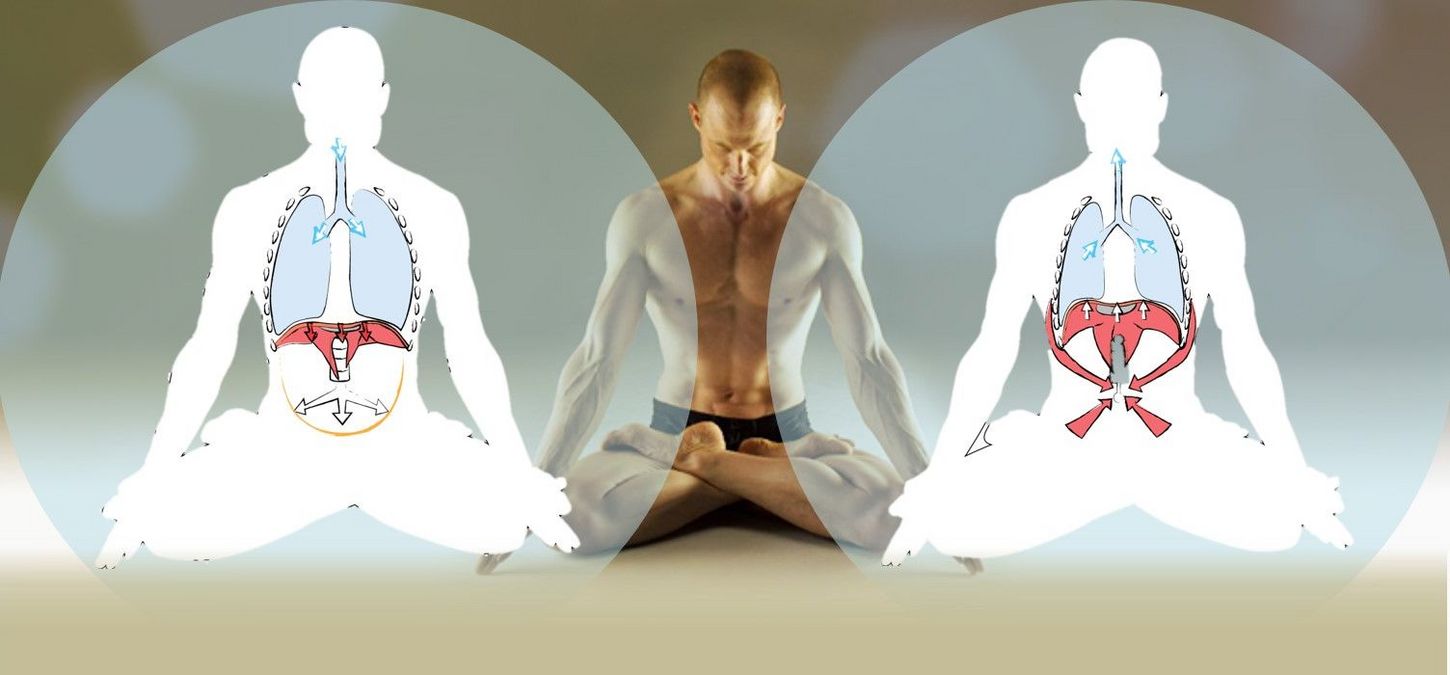

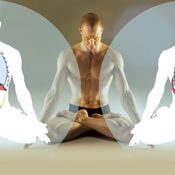
 Dr. Ronald Steiner
Dr. Ronald Steiner
